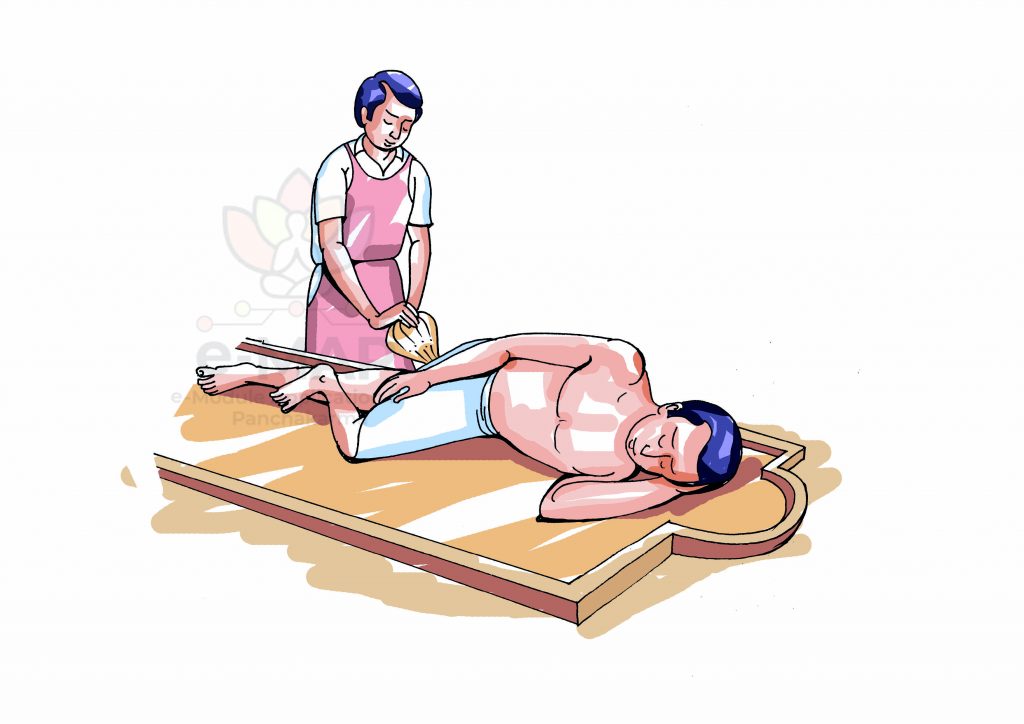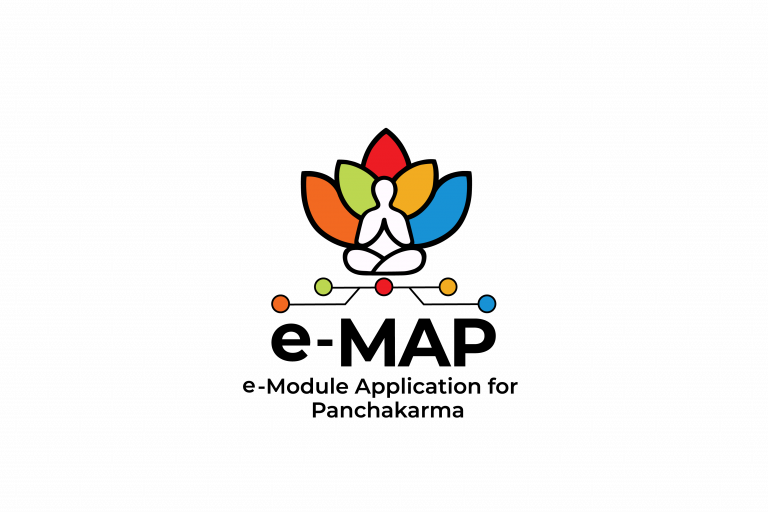
UG Module 6 - Lesson 12
BASTI KARMA

EXPLANATORY NOTES
Samyak Anuvāsita Lakṣaṇa
प्रत्येत्यसक्तं सशकृच्च तैलं रक्तादिबुद्धीन्द्रियसम्प्रसादः
स्वप्नानुवृत्तिर्लघुता बलं च सृष्टाश्च वेगाः स्वनुवासिते स्युः||
(Cha. Si. 1/44)
Proper administration of Anuvāsana Basti give rise to the following signs and symptoms
Return of the Sneha with Purīṣa without any obstruction. Nourishment of Raktadi Dhātus, clarity of intellect and senses, good and continuous sleep, lightness and strength in the body and proper elimination of natural urges without any obstruction.
Anuvāsana Ayoga Lakṣaṇa
अधःशरीरोदरबाहुपृष्ठपार्श्वेषु रुग्रूक्षखरं च गात्रम्
ग्रहश्च विण्मूत्रसमीरणानामसम्यगेतान्यनुवासितस्य || (Cha. Si. 1/45)
Improper administration of Anuvāsana Basti give rise to the following signs and symptoms
Pain in the lower part of the body, abdomen, arms, back and flanks, dryness and roughness of the body and obstruction in the passage of stool, urine and flatus.
Anuvāsana Atiyoga Lakṣaṇa
हृल्लासमोहक्लमसादमूर्च्छाविकर्तिका चात्यनुवासितस्य| (Cha. Si. 1/46)
Excessive administration of Anuvāsana Basti gives rise to nausea, unconsciousness, physical fatigue, mental fatigue, exhaustion, fainting and gripping pain in the anus.
ANUVĀSANA BASTI VYĀPAT
According to Caraka, complications due to Sneha Basti are six in number. They are
वातपित्तकफात्यन्नपुरीषैरावृतस्य च|
अभुक्ते च प्रणीतस्य स्नेहबस्तेः षडापदः|| (Cha. Si. 4/25)
CARAKA | SUŚRUTA |
|
|
Sneha Basti Vyāpat according to Ācārya Caraka
SL NO | Vyāpat | Nidāna | Lakṣaṇa |
Cikitsā |
1 | Vātāvrita Sneha Basti | Śīta Basti / Alpa Bala Basti given in Vātādhika condition |
|
|
2 | Pittāvrita Sneha Basti | Ati Uṣṇa Basti in Pittādhika condition |
| Nirūha Basti- with Madhura Tikta Dravya |
3 | Kaphāvrita Sneha Basti | Mrdu Basti in Kaphādhika Avasthā |
| Nirūha Basti – With Sura, Gomūtra, Madanaphala Taila and Kaṣāya, Kaṭu, Tīkṣṇa, Uṣṇa Dravyas |
4 | Annāvrita Sneha Basti | Guru Basti after Atibhojana |
|
|
5 | Purīṣāvrita Sneha Basti | Alpa Bala Basti given in Mala Sañcaya Avasthā |
|
|
6 | Abhukte Pranīta Sneha Basti | Ati Pīḍana of Sneha Basti in Abhukta Śūna Pāyu | Basti Dravya reaches upwards because of the absence of any obstruction and will reach throat and may come out from the upper orifice of the body. |
|
Sneha Basti Vyāpat according to Ācārya Suśruta
SL NO | Vyāpat | Nidāna | Lakṣaṇa |
Cikitsā |
1 | Vātābhibhūta Sneha Basti | Śīta Basti / Alpa Bala Basti given in Vātādhika condition |
| Doṣa Śāmaka Basti |
2 | Pittabhibhūta Sneha Basti | Ati Uṣṇa Basti in Pittādhika condition |
| Doṣa Śāmaka Basti
|
3 | Slesmābhibhūta Sneha Basti | Mrdu Basti in Kaphādhika Avasthā |
| Doṣa Śāmaka Basti |
4 | Annābhibhūta Sneha Basti | Guru Basti after Atibhojana |
|
|
5 | Malavrita Sneha Basti | Alpa bala Basti given in mala sanchaya avasthā |
| Tīkṣṇa Nirūha and Tīkṣṇa Anuvāsana Basti |
6 | Dūranusrita Sneha Basti | Sneha Basti if administered in persons after Śodhana (Virecana) |
|
|
7 | Asvinnasya Vyāpat | Śīta and Mrdu Basti administerd in Aśodhita person in little amount |
| Āsthāpana and Anuvāsana Basti |
8 | Alpa Bhuktavate Alpa Aśanasya Vyāpat | If Alpa Mātrā , Mridu Anuvāsana administered after small diet |
| Śodhana, Āsthāpana and Sneha Basti |
COMMONLY ENCOUNTERED COMPLICATION
- Agnimāndya
- Adhmāna
- Atisāra
- Udara Śūla
- Burning sensation in abdomen
- Jvara
- Heaviness of body
Precautions to avoid complications
- Vital parameters like BP, PR should be checked before and after treatment
- Per rectal examination
- Proctoscopy examination to rule out piles, fissure,…
- Counselling of patient
- Explain the whole procedure to patient
- Doctor should wear gloves during procedure
- Sterilization of Netra, vessels to avoid infection
- Use proper quantity of ingredients
- Use good quality ingredients
- Advice the patient to maintain personal hygiene
- Temperature of Basti Dravya should be checked
- Ensure no air filled up in Basti Yantra
- Should not dip finger in Basti Dravya directly for checking temperature
- Lubricate nozzle and Guda
- Introduce nozzle parallel to vertebral column
- Avoid complete evacuation of Basti Dravya, should remain 25-30 ml
- Should advice to take bath and have food soon after excretion in case of Nirūha Basti
- Should monitor the patient to avoid complications like stroke
PRACTICALLY OBSERVED COMPLICATIONS AND MANAGEMENT
COMPLICATIONS | TREATMENT |
|
|
|
|
|
|
|
|
|
|
|
|
|
|
|
|
|
|
|
|
Complications should be managed only after proper examination. Complications which need emergency management like stroke, heart problems,… should be referred to higher centres | |
PARIHĀRYA VIṢAYA AFTER ANUVĀSANA BASTI
अत्यासनस्थानवचांसि यानं स्वप्नं दिवा मैथुनवेगरोधान् ||
शीतोपचारातपशोकरोषांस्त्यजेदकालाहितभोजनं च | (Cha. Si. 1/54)
Here Caraka advises to avoid Excessive sitting, standing, speaking and travelling, day sleep, sexual intercourse, suppression of manifested natural urges, cooling regimens, exposure to sun, grief and anger and intake of untimely and unwholesome food after doing Pañcakarma.
एतां प्रकृतिमप्राप्तः सर्ववर्ज्यानि वर्जयेत्|
महादोषकराण्यष्टाविमानि तु विशेषतः||
उच्चैर्भाष्यं रथक्षोभमविचङ्क्रमणासने|
अजीर्णाहितभोज्ये च दिवास्वप्नं समैथुनम्||
तज्जा देहोर्ध्वसर्वाधोमध्यपीडामदोषजाः|
श्लेष्मजाः क्षयजाश्चैव व्याध्यः स्युर्यथाक्रमम्|| (Cha. Si. 12/10-12)
The Aṣṭa Mahā Doṣakara Bhāvas are the eight factors which are Apathya during Śodhana procedures. They are Ucchabhāsana, Rathakṣobha, Aticaṅkramaṇa, Atyaśana, Ajīrṇa, Adyaśana or Ahita Bhojana, Divāsvapna and Maithuna. As Uchhabhashya leads to Ūrdhva Bhāga Deha Rogas. Rathakshobha leads to Sarva Deha Rogas. Aticaṅkramaṇa leads to Adho Deha Rogas, Atyaśana leads to Madhya Deha Rogas. Ajīrṇa and Ahita Bhojana leads to Āma doṣa. Divāsvapna leads to Kaphaja Rogas and Maithuna leads to Kṣayaja Rogas.
PARIHĀRA KĀLA
कालस्तु बस्त्यादिषु याति यावांस्तावान् भवे द्विपरिहारकालः| (Cha. Si. 1/54)
One should follow the restrictions and diet, double the duration taken for the treatment.
यान्यहानि पिबेत्तानि तावन्त्यन्यान्यपि त्यजेत्| (A. H. Su. 16/28)
The restrictions should be followed for same number of days taken for the treatment.
IMPORTANT SLOKA
प्रत्येत्यसक्तं सशकृच्च तैलं रक्तादिबुद्धीन्द्रियसम्प्रसादः
स्वप्नानुवृत्तिर्लघुता बलं च सृष्टाश्च वेगाः स्वनुवासिते स्युः|| (Ch. Si. 1/44)
Proper administration of Anuvāsana Basti give rise to the following signs and symptoms
Return of the Sneha with Purīṣa without any obstruction. Nourishment of Raktadi Dhātus, clarity of intellect and senses, good and continuous sleep, lightness and strength in the body and proper elimination of natural urges without any obstruction.
अधःशरीरोदरबाहुपृष्ठपार्श्वेषु रुग्रूक्षखरं च गात्रम्
ग्रहश्च विण्मूत्रसमीरणानामसम्यगेतान्यनुवासितस्य || (Ch. Si. 1/45)
Improper administration of Anuvāsana Basti give rise to the following signs and symptoms
Pain in the lower part of the body, abdomen, arms, back and flanks, dryness and roughness of the body and obstruction in the passage of stool, urine and flatus.
हृल्लासमोहक्लमसादमूर्च्छाविकर्तिका चात्यनुवासितस्य| (Ch. Si. 1/46)
Excessive administration of Anuvāsana Basti gives rise to nausea, unconsciousness, physical fatigue, mental fatigue, exhaustion, fainting and gripping pain in the anus.
वातपित्तकफात्यन्नपुरीषैरावृतस्य च|
अभुक्ते च प्रणीतस्य स्नेहबस्तेः षडापदः|| (Ch. Si. 4/25)
Complications due to Sneha Basti are six in number. They are Vātavrita Sneha Basti, Pittāvrita Sneha Basti, Kaphāvrita Sneha Basti, Athyannāvrita Sneha Basti, Purīṣāvrita Sneha Basti and Abhukta Pranīta.
अत्यासनस्थानवचांसि यानं स्वप्नं दिवा मैथुनवेगरोधान् ||
शीतोपचारातपशोकरोषांस्त्यजेदकालाहितभोजनं च | (Ch. Si. 1/54)
Here Caraka advises to avoid Excessive sitting, standing, speaking and travelling, day sleep, sexual intercourse, suppression of manifested natural urges, cooling regimens, exposure to sun, grief and anger and intake of untimely and unwholesome food after doing Pañcakarma.
एतांप्रकृतिमप्राप्तःसर्ववर्ज्यानिवर्जयेत्|
महादोषकराण्यष्टाविमानितुविशेषतः|
उच्चैर्भाष्यंरथक्षोभमविचङ्क्रमणासने|
अजीर्णाहितभोज्येचदिवास्वप्नंसमैथुनम्||
तज्जादेहोर्ध्वसर्वाधोमध्यपीडामदोषजाः|
श्लेष्मजाःक्षयजाश्चैवव्याधयःस्युर्यथाक्रमम् |
(Ch.Si.12/10-12)
The Aṣṭa Mahā Doṣakara Bhāvas are the eight factors which are Apathya during Śodhana procedures. They are Ucchabhāsana, Rathakṣobha, Aticaṅkramaṇa, Atyaśana, Ajīrṇa, Adyaśana or Ahita Bhojana, Divāsvapna and Maithuna. As Uchhabhashya leads to Ūrdhva Bhāga Deha Rogas. Rathakshobha leads to Sarva Deha Rogas. Aticaṅkramaṇa leads to Adho Deha Rogas, Atyaśana leads to Madhya Deha Rogas. Ajīrṇa and Ahita Bhojana leads to Āma doṣa. Divāsvapna leads to Kaphaja Rogas and Maithuna leads to Kṣayaja Rogas.
कालस्तु बस्त्यादिषु याति यावांस्तावान् भवे द्विपरिहारकालः| (Ch. Si. 1/54)
One should follow the restrictions and diet, double the duration taken for the treatment.
यान्यहानि पिबेत्तानि तावन्त्यन्यान्यपि त्यजेत्| (AH. Su. 16/28)
The restrictions should be followed for same number of days taken for the treatment.



